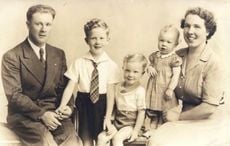We are on the brink of that time of year that ye beautifully call the fall. One of the indications of that reality are shorter and slightly chillier evenings.
Another linked happening is the presence over a growing number of chimneys of the dribbles and squiggles of smoke which reveal that families are lighting up their hearths again after the summer break.
Stand and sniff, though, and you will quickly and probably sadly enough realize that fewer and fewer of the hearth fires are burning turf like the old days, as I discussed in last week’s column.
I have often been surprised at the number of returned Irish and Irish American visitors to these shores who quite literally rave about the aromatic impact on their spirits of genuine turf fires.
The glowing herbal cores of them touch some memory chordage for sure. My warning tidings, before I go any further, are that turf-fired hearths, either in homes or in public places like pubs and restaurants, are becoming harder and harder to find in today's Ireland and may disappear altogether inside the next decade.
Before that, however, I have to divert to tell ye all that the four MacConnell boys from Belnaleck on the shores of Lough Erne were the world's very first rock 'n’ rollers because of the huge turf fires which always burned throughout our childhood, day and night. I can smell and even taste them yet.
It was not just then turf fires, however, which turned us into rock 'n’ rollers back in the forties, but the presence close to the hearth of the great wooden rocking cradle where we all slept in our turn as babies.
And the fact that Sandy and Mary's home, our home, was what was called locally a ceili house with an unending stream of visitors. Most came initially to buy their daily needs in Sandy's little country shop attached to the gable. Others, though, came for the craic and the singing and, especially in later years, the music making.
Everyone who sat beside the cradle in our early years automatically rocked it as they chatted and drank their cups of tea. And when that visitor departed, the next person to occupy the fireside chair beside the hearth continued the rocking. It went on for hours every night of the week.
A consequence was that when Mary put us to bed we continued to rock and roll our small heads on the pillows. And that continued for all of us long after our cradle days, probably, thinking back, until we were eight or nine years old.
And we would usually sing ourselves to sleep too, believe it or not. It was that kind of special home.
Back to the turf in the hearth. We cut our own turf like about every other family in the parish. Because Sandy had arthritis he could not cut the bog in the Crocken area himself, so he would hire his friend Pee Flanagan to cut the turf for us from a rented bog bank and, later, after it had been clamped in small piles and saved and dried, ferried home to our shed by donkey and cart for the winter.
And that turf, I will have ye know, was called fum turf.
You see, there are many kinds of traditional turf. Our fum turf from the Crocken bog was very light and very brown and had dried white tendrils of grass and herbs clinging to every sod like whiskers.
It was great turf for reviving last night's fire, blazing up quickly, acting like kindling, but it was not much good for a sustained good warm fire on a cod night.
Accordingly, Sandy had to supplement it with a horse cartload of what was called stone turf from the next bog. This was heavy and black as coal and delivered almost as much heat.
It was called stone turf because it was cut from relatively shallow layers of turf atop limestone underlay. It was prized and rightly so. You will not find much of that special turf in the New Ireland.
A lovely spinster aunt called Lizzie raised my mother, who came from the home of a widow with a large family of girls. When Lizzie became old she came to live in our house, a gentle presence that we called Grannie Lizzie.
She told us stories very often early in the evenings when there were no visitors yet, or very few, and one of her best stories was about the fum turf that would be just beginning to flame up in the fire as we sat around listening.
When the flames flickered up around the sods of turf, the strands of dried grass and herbs would sometimes flare up quickly and whitely and very brightly indeed and send sparklers up the big chimney. Lizzie would then bless herself, tell us to do the same, and say that was an Irish fairy escaping towards paradise.
She related how the Irish fairies had retreated into the bogs when the English armies came to Ireland, and when the Irish lost the war they stayed hidden in a kind of coma in the Crocken bog. It took the heat of a good fire to enable them to escape.
“And where do they go Lizzie?” we would ask. And she would reply they went all the way up to paradise where there were no English soldiers at all.
There was a fireplace in her bedroom. A fire was burning there when she died at a big age, serenely slipping away.
I remember Sandy putting a few sods of turf on the fire to keep it alive when the neighbour's came to the wake, to kneel briefly in prayer at the bedside and say goodbye. The normal ritual.
Brother Sean and sister Maura were with me in the room when one of the sods flared brightly the way they did, and Sean said that was surely Lizzie flying away up to Heaven to join her fairies. I recall that clearly.
Both he and Maura and Sandy and Mary are up there with her now in another dimension so near yet so far away. I hope there is a hearth where they are. There is certainly a bit of craic going on as always.




Comments